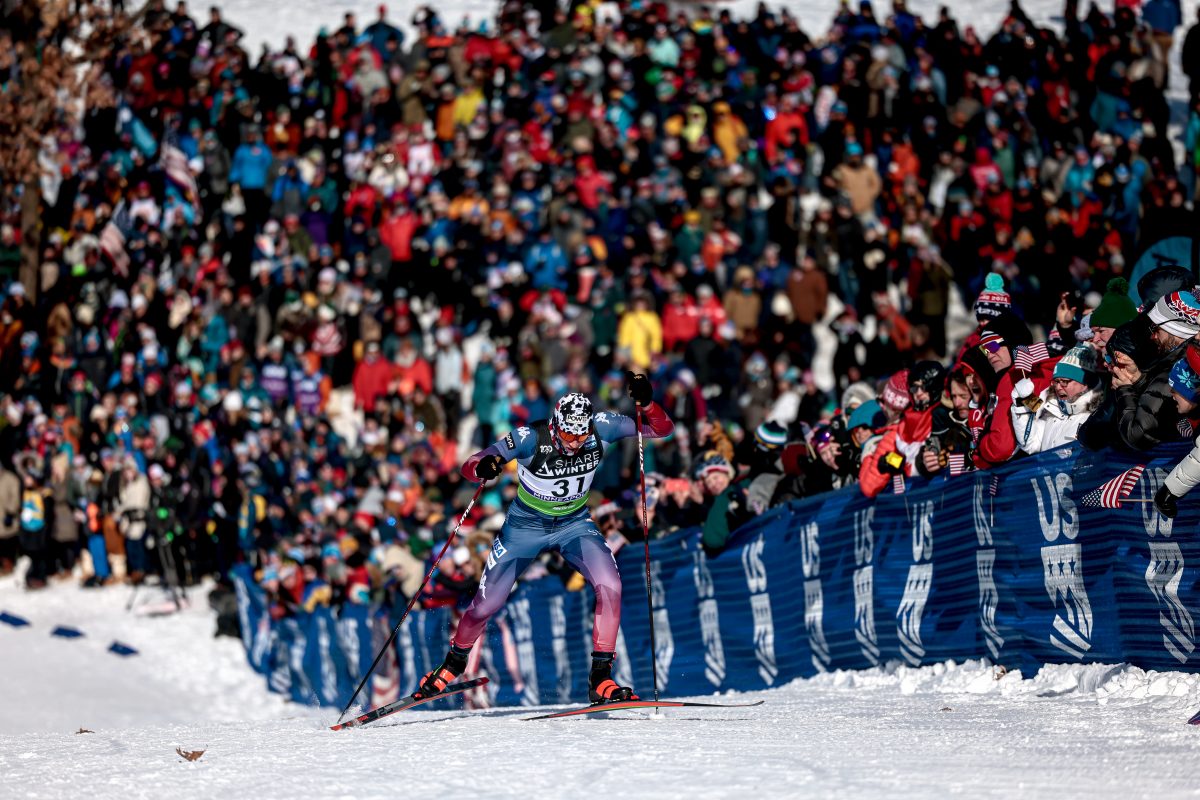
Whistler, British Columbia – The US men’s sprint relay team of Torin Koos and Andy Newell finished 9th after advancing out of the semifinals with a strong performance, before falling off the back with a lap and a half to go.
Koos and Newell finished 2nd in their semifinal, edging France in a photo finish. The top three automatically advanced so the lunge at the line was not critical. It might have been had not the Belorussian team, well clear in the lead, skied in to the lap lane, and never finished the race.

“We had really hard semifinal. We had to get in the top-3 and not go for one of the lucky loser spots,” said Koos.
Newell concurred on the difficulty of the first heat.
“I pushed way too hard on that last lap of the semifinal. I was really hurting.”
Newell has talked about his issues with building up too much lactic acid early in sprint races and the challenges that raises. Today he suffered for his effort, but felt ready to go for the final.
“I needed the full 45 minutes to recover. I was puking pretty badly between the heats, even up until 30 minutes after the semi. I built up way too much lactic acid – I killed myself in that heat. But I was able to recover ok and felt pretty good in the final despite that.”
Koos rode a stationary bike in between laps to work out lactic acid and keep his legs loose.
The US duo stayed strong through four laps of the final, maintaining position in the lead pack. Koos looked particularly good, moving up at the beginning of each of his laps.
But the wheels came off midway up the final climb on the 5th loop with Koos skiing.
“Today I felt like I did what I could do,” said Koos. “I was put on the pain-frame [when German Tim Tscharnke made a powerful move on the last climb]. I tried to go and I almost went the opposite way. The mind wanted to go, but the body couldn’t.”

Until that point, Koos felt good.
“We were pushing the pace a lot the whole race, but those distance skiers finally tired us out…I had to dig down and the well was dry.”
Koos got out to a fast start in the final, leading early.
“I tried to get out for a good start and was I just being a little crafty out there,” he said. “I didn’t want any broken poles, so I just found my way to the front. I wasn’t pushing the pace when I was at the front. I was slowing it down.”
And while Newell doesn’t feel position in the first laps is overly critical, it holds extra importance for the US team.

“It’s not super important [getting in good position early], but for us, we are all about having clean tags. You can make up so much time in having good tags and we had great tags all day long. You can pick up a few seconds every lap so if you are up toward the front it makes it easier to stay out of trouble and make a clean tag.”
Newell was unable to make up any of the ground that Koos lost on that final climb.
“The acceleration was too much. We kind of got caught back a bit when we tagged – that 10 or 15 meters is so hard to make up on the last lap. You really need to be among the top3 or 4 on the final lap. We weren’t there, but we fought as hard as we could.”
Both Koos and Newell said they were pleased with the day overall, but obviously wanted more.
“I’d love to say we just won the first medal since 1976…but we were close as we have ever been in my era of skiing, so it is close.”
Making the jump from skiing two laps each with the leaders, to completing the race at the front is significant. In this type of race, 10 meters is a large gap, so, as Newell explained, to be competitive you need to be right there the entire race. While the Americans fought hard, they still need to step it up another level to be in the hunt for the podium. It is also worth noting that in the team sprint, the Olympic field is often weaker than a World Cup field. This is because each nation can only start one team, while on the World Cup, Norway, Sweden and other powerhouses can have several.
“This is the hardest race in skiing right here, because it is this crazy middle ground where all the best distance skiers and all the best sprinters are knocking heads,” concluded Koos.


Topher Sabot
Topher Sabot is the editor of FasterSkier.



3 comments
sully
February 23, 2010 at 6:09 am
Awesome to see both our Men and Women get into the Final! My kids and I sat on the couch and cheered loudly, as it was so cool to have the U.S. involved and competitive in this highly entertaining nordic event.
miwi
February 23, 2010 at 7:04 pm
It was great watching the boys ski so well in the final. Watching Torin move to the front and ski with authority was wonderful.
Though I wonder why the Topher keeps talking about lactic acid. Why does the myth of lactic acid continue? There have been plenty of articles, even in the NY Times explaining that lactic acid isn’t what is causing the problems with endurance athletes. It is processed very quickly and is used as a source of fuel by the body. Let’s try to rid the world of the myth of lactic acid being the root of all muscle problems.
Congrats to Andy and Torin for skiing their way to the final and mixing it up throughout the race!
FasterSkier
February 23, 2010 at 7:43 pm
The references to lactic acid come directly from Andy Newell. In the article, there is a direct quote from Newell talking about his issues with building up lactic acid in this race specifically, and he has talked about it in the past.
He might have it wrong, but that is what he says can be a limiting factor.